|
World War II (1939-1945) and the "Happy Time" (1940-41)
1939 When Hitler told Dönitz early in the year that he was planning for a war six years in the future, Dönitz developed plans for the construction of a U-boat fleet of 300 Type VII boats. This would allow for 100 on station, 100 in transit, and 100 in training or under repair. However, Germany moved into Czechoslovakia in March and invaded Poland on September 1. On the 3rd, the British issued an ultimatum: Get out of Poland. You have two hours to make up your mind. The Germans did not respond. World War II began. Germany then had 57 U-boats in service, only 38 of which could be considered `seagoing.` For the time being, it would be enough.
The U-boat war started under `prize rules`, but that policy did not last long. On the very first day, U-30 sank the liner Athenia without warning, and 122 of 1,100 passengers perished, including 28 Americans.
Toward the end of September, the High Command authorized “seizure or sinking without exception” for merchant ships trying to radio for help when ordered to stop. A week later, U-boats received the order to sink without warning any ship sailing without lights, with commanders instructed to enter a note in the log that the sinking was “due to possible confusion with a warship or auxiliary cruiser”.
By November, the Germans had withdrawn all pretenses with Standing Order No. 154: “Rescue no one and take no one aboard . . . Care only for your own boat and strive to achieve the next success as soon as possible! We must be hard in this war”.
In June 1940, France signed an armistice with Germany, and soon three French bases gave U-boats more convenient access to the open ocean. The 18 months between July 1940 and December 1941 were known, to the German submarine force, as the `happy time`.
Fleet headquarters in Germany directed U-boat operations by long-range radio. The Germans assumed the Allies would intercept the traffic but didn`t care, because they were encoding all messages. However, even coded intercepts were useful; the Allies could identify many individual boats by their unique radio signature. Even if an Allied plane or ship could not establish a submarine`s firm position, an analyst could determine when a boat would be near the end of a mission and therefore headed home along one of several reasonably predictable routes.
In June 1940 Italy joined Germany, bringing 105 submarines to the Mediterranean theater. They do not seem to have had much impact.
On August 17th, Hitler formally declared a total blockade of the British Isles.
One example: On October 16, one U-boat spotted a convoy of 35 ships and called in the rest of his pack, six more boats. Another boat joined the next day. After three days, the U-boats had sunk 17 of those ships, had intercepted two other convoys, and sent 21 more ships to the bottom, without a single U-boat loss. The tally would have been higher, but most of the submarines had fired all of their torpedoes and had to go home to re-load.
On December 7, 1941 Japan attacked the American naval base at Pearl Harbor, Hawaii.
The major effects of the attack: to coalesce American public opinion as never before, and to force the US Navy to abandon an ingrained fascination with battleships and shift the burden to the new-generation warships: the aircraft carrier and the submarine. At that time, the US Navy had 111 submarines in commission, including 60 in the Atlantic and 51 in the Pacific, but many were barely capable. They commissioned Gato at the end of the month, yet it would be several years before a fully capable submarine force was in place.
1942 The Battle Of The Atlantic began in July and continued for 11 months, with U-boats claiming some 712 merchant victims. They were sinking ships at more than twice the replacement rate, and new U-boats were joining the fleet at a rate of about one a day.
Technological advances such as improved radar, the radar altimeter, the aircraft searchlight, and effective air-dropped depth charges began to enter the force. Before long, aircraft could claim participation in 50 percent of all U-boat sinking.
By the end of 1942, with the U-boat fleet clearly in trouble, Hitler authorized the design of a fully combat-capable, Walter-cycle, 1,600-ton U-boat designated Type XVIII. Two prototypes were ordered, but it soon became clear that not enough time or money existed to turn this dream into reality. The Germans converted the design into a conventionally powered submarine, diesel on the surface, batteries for submerged running, and the rather large space intended for storage of the Perhydrol was given over to an extra-large bank of batteries.
The Germans ordered two new classes. The 1,600-ton Type XXI had only half the range of the comparable Type IX, could manage bursts of 17 knots underwater (compared with seven knots in the Type IX), dive to almost 1,000 feet (300 feet deeper), and remain totally submerged at economical creep speed for 11 days. With a sophisticated fire control system, the Type XXI could launch an attack from a depth of 150 feet.
The 230-ton coastal submarine Type XXIII, meanwhile, had twice the submerged speed and five times the underwater endurance of the small pre-war Type II. However, combat effectiveness was severely limited: two torpedoes, no reloads.
The Germans quickly phased out all other submarine construction in favor of Type XXI and Type XXIII.
In 1943 The Germans underestimated the industrial capacity of the US. The prediction under which `Tonnage War` was by then being waged was that the 1943 ship production of Great Britain and the US together would be less than eight million tons. The US alone launched more than double that figure.
The Germans also underestimated the ability of the Allies to develop and implement highly effective anti-submarine weapons and tactics. During the year, the US Navy established anti-submarine `Hunter-Killer` groups centered on a small, quickly built so-called `jeep` carrier, from which perhaps a dozen airplanes might operate. Long-range aircraft went into service, including the B-24, which was adapted for anti-submarine efforts. Among other efforts, they put an end to the `Milk Cow`. The rendezvous were too easy to spot by air patrol. Out of nine Type XIV in service in June 1943, seven had been sunk by August.
By the end of May 1943, the Germans had clearly lost The Battle Of The Atlantic. In that month alone, the Allies sank 41 U-boats, representing 25 percent of Germany`s current operational U-boat strength. Things got worse: In the final four months of the year, during which almost 5,000 ships sailed in Atlantic convoys and only nine were lost, the Allies destroyed 62 U-boats.
In 1944 Germany also pursued weapons of desperation, developing a two-man, two-torpedo midget submarine called the Seehund. Thirty-nine feet long and weighing 15 tons, Seehund could dive to 165 feet with a surface range of 120 miles at eight knots or 250 miles at five knots; submerged, 20 miles at five knots, 60 miles at three knots. When the war ended in May 1945, the Germans had at least 268 Seehunds ready for service.
1945 How each country`s submarines fared during the war?
Germany
U-boats claimed 14.4 million tons, but Germany lost 821 U-boats Allied aircraft were responsible for (or directly involved in) the loss of 433 U-boats; surface ships, 252; accidents, 45; mines, 34; submarines 25 (only one of which happened when both hunter and victim were submerged); unknown, 15; scuttled by their own crews, 14; interned in neutral ports, 2; sunk by shore battery, 1.
United States
American submarines sank at least 1,300 Japanese ships, 5.3 million tons, including one battleship, eight carriers, 11 cruisers, and 180 smaller warships. The US Navy lost 52 boats; 22 percent of the submarine personnel who went on patrol did not return. It was the highest casualty rate of any branch of service, though not as high as that of the German submarine force, which lost an astonishing 630 men out of every 1,000 who served in the U-boat fleet.
Soviet Russia
The Soviets started the war with the largest submarine fleet: 218. They added 54 and lost 109. They did not have much impact on the course of the war, though S-13 was credited with the single greatest disaster in maritime history: the 1945 sinking of the German liner Wilhelm Gustloff, which was engaged in an effort to get German soldiers out of the path of the advancing Red Army. More than 8,000 troops and civilians may have been aboard; fewer than 1,000 were rescued.
Japan
Japanese submarines had great success early in the war, especially in the Indian Ocean area. But the tide of battle began to turn with the Allied invasion of Guadalcanal in August 1942, and the Japanese pulled submarines off combat duty and assigned them to carry vital supplies to beleaguered troops or to pull troops out of failing campaigns. The Japanese built submarine landing ships and 28 cargo submarines. Japanese submarines did score a few important victories, including the carriers Yorktown and Wasp and the last American surface warship sunk, the cruiser Indianapolis in late July 1945. Overall, however, they sank only about one-fifth as many ships as the American submarine force did.
On the last day of the Pacific war, Japan had only 33 submarines in commission (excluding midgets), seven of which were in the training command. Except for the midgets, the submarine force had become irrelevant.
Britain and her Allies
Holland, Poland, France, Norway and Greece, had sank two million tons of enemy shipping and 57 major war vessels. They sank 36 enemy submarines most of them caught on the surface. What was the cost of these successes? Of 206 full-sized boats operated by the Royal Navy during World War II, 74 were lost half in the Mediterranean theatre. Allies loses: 7 Dutch, 3 France, 3 Greek, 2 Polish and 1 Norwegian.
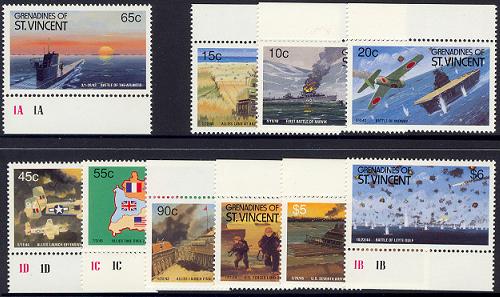 |
Saint Vincent & Grenadines |
1990 |
50th anni` of WW-II (set of 10 stamps) |
 |
Canada |
1992 |
1939-1945 Second World War. Dark days indeed (set of 4 stamps) |
 |
Canada |
1993 |
1939-1945 Second World War. The tide begins to turn (set of 4 stamps) |
 |
Antigua & Barbuda |
1994 |
50th anni` of D-Day, 6th June 1944 (set of 3 stamps) |
 |
Saint Lucia |
1995 |
German U-Boat off St' Lucia |
 |
Saint Lucia |
1995 |
50th anni' of the end of World War-II (set of 4 stamps) |
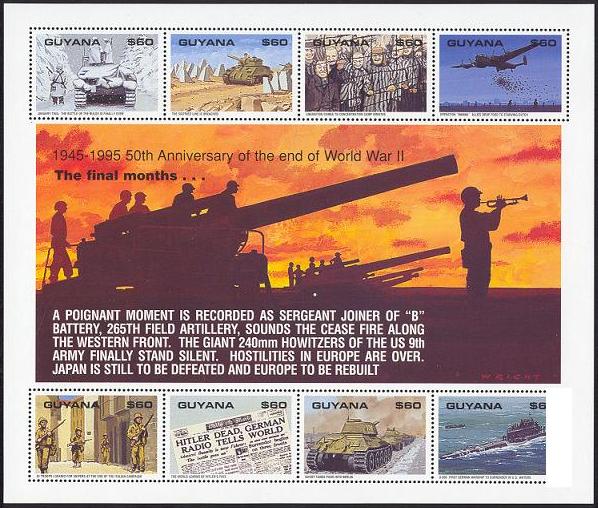 |
Guyana |
1995 |
50th anni` of the end of WW-II (souvenir sheet of 8 stamps) |
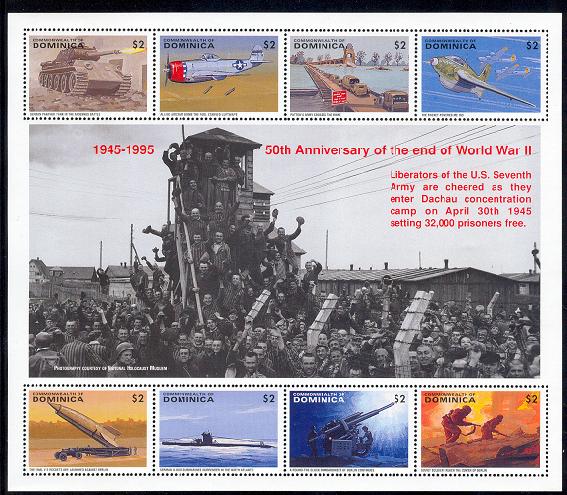 |
Dominica |
1995 |
50th anni` of the end of WW-II (sheetlet of 8 stamps) |
 |
Cayman Is. |
1995 |
50th anni' of the end of WW-II (set of 4 stamps+ss) |
 |
Bahamas, The |
1995 |
50th anni` of the end of WW-II (set of 4 stamps) |
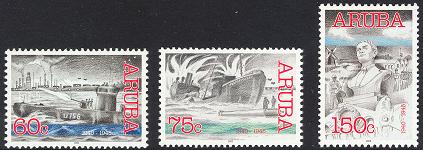 |
Aruba |
2002 |
History of WW-II (set of 3 stamps) |
 |
Guinea-Bissau |
2005 |
II Guerra Mundial- Submarinos, Wold War II- Submarines (souvenir sheet) |
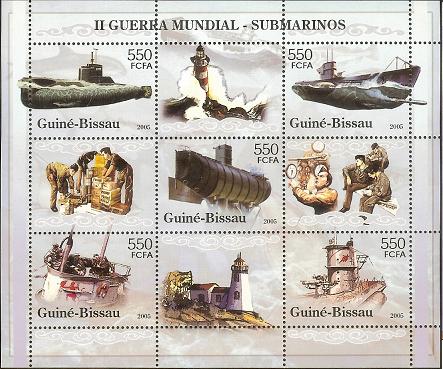 |
Guinea-Bissau |
2005 |
II Guerra Mundial- Submarinos, Wold War II- Submarines (sheetlet of 5 stamps) |
|